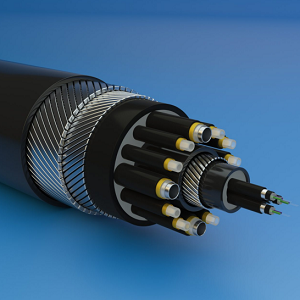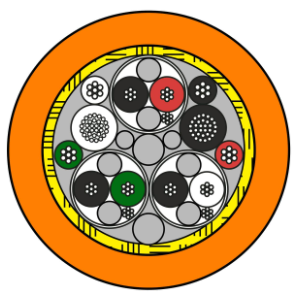
Umbilical cable is an important facility in the subsea production system for the offshore oil exploitation. It provides a control and communication link between the surface vessel and the subsea equipment. The umbilical cable is a composite structure that is composed of multiple components and various materials. A typical umbilical cable usually consists of tubes or hoses, optical fibre cables, electrical cables, inner sheaths and fillers which are assembled into an inner core. Steel armor wires are used to provide the tension capability or to achieve the necessary stability. The outer sheath provides protection for the inner components (ISO, 2009). Umbilical cables should maintain sufficient tension stiffness to withstand large loads induced by self-weight, wave and the motion of the surface vessel, which leads to an urgent requirement for the prediction of the mechanical behaviour.
Umbilical cable for ROV

Fiber Count : 1~20cores
Electric Unit : 4 x 3 x 4m2 (category 5)
Inner sheath : Black HDPE
Outer armoure : Galvanised steel wire(GSW)
Outer sheath : Black HDPE
Applications: used for early warning and monitoring
of coastal waters and ports.
Features: longitudinal water-ingress proof cable core section
good flexibility, excellent repeated bending performance, retractable in numerous times
transmission of both optical signals and power feeding
Double HDPE layers, excellent redial water blocking performance
12 Cores Umbilical Cable

Strength member: Vectran fiber braid
Outer jacket: Orange polyurethane (1,5 mm)
Outside diameter: Ø 12,2 mm
Electrical resistance conductors 18 AWG : < 19,50 ohm/km @ 20°C
Working voltage :250 V
Weight in air :155 kg/km
Weight in fresh water: 38 kg/km
Weight in sea water :35 kg/km
Breaking strength :1500 kg
Working load max.: 375 kg
Static bending radius min. :61 mm
Dynamic bending radius min. :122 mm
Operating temp -40°c – +90 °C
Length available up to 1000 m
